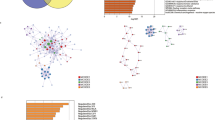Abstract
Kahweol, the coffee-specific diterpene, has been reported for its tumor cell growth inhibitory activity and anti-carcinogenic activity. The mechanism by which kahweol initiates apoptosis remains poorly understood. In the present study, we investigated the effect of kahweol on the apoptotic pathway in U937 human promonocytic cells. We show that kahweol induces apoptosis in association with the activation of caspase 3 and cytochrome c release from the mitochondria to the cytosol, as well as down-regulation of anti-apoptotic proteins (Bcl-2, Bcl-xL, Mcl-1 and XIAP). Kahweol altered the phosphorylation state of members of the MAPKs and Akt. Ectopic expression of Bcl-2 or constitutive active Akt (myr-Akt) in U937 cells attenuates kahweol-induced apoptosis. In addition, we have also shown that JNK and Akt signal pathway plays a crucial role in kahweol-induced apoptosis in U937 cells. Taken together, our results show the activity of kahweol to modulate multiple components in apoptotic response of human leukemia cells and raise the possibility a novel therapeutic strategy in hematological malignancies.





Similar content being viewed by others
References
Wyllie AH (1995) The genetic regulation of apoptosis. Curr Opin Genet Dev 5:97–104
Thompson CB (1995) Apoptosis in the pathogenesis and treatment of disease. Science 267:1456–1462
Newman DJ, Cragg GM, Snader KM (2003) Natural products as sources of new drugs over the period 1981–2002. Nat Prod 66:1022–1037
Kanda H, Miura M (2004) Regulatory roles of JNK in programmed cell death. J Biochem 136:1–6
Wullaert A, Heyninck K, Beyaert R (2006) Mechanisms of crosstalk between TNF-induced NF-kappaB and JNK activation in hepatocytes. Biochem Pharmacol 72:1090–1101
Dhanasekaran DN, Reddy EP (2008) JNK signaling in apoptosis. Oncogene 27:6245–6251
Martelli AM, Nyakern M, Tabellini G, Bortul R, Tazzari PL, Evangelisti C, Cocco L (2006) Phosphoinositide 3-kinase/Akt signaling pathway and its therapeutical implications for human acute myeloid leukemia. Leukemia 20:911–928
Xu Q, Simpson SE, Scialla TJ, Bagg A, Carroll M (2003) Survival of acute myeloid leukemia cells requires PI3 kinase activation. Blood 102:972–980
Longo PG, Laurenti L, Gobessi S, Sica S, Leone G, Efremov DG (2008) The Akt/Mcl-1 pathway plays a prominent role in mediating antiapoptotic signals downstream of the B-cell receptor in chronic lymphocytic leukemia B cells. Blood 111:846–855
Higdon JV, Frei B (2006) Coffee and health: a review of recent human research. Crit Rev Food Sci Nutr 46:101–123
Cavin C, Holzhaeuser D, Scharf G, Constable A, Huber WW, Schilter B (2002) Cafestol and kahweol, two coffee specific diterpenes with anticarcinogenic activity. Food Chem Toxicol 40:1155–1163
Tao KS, Wang W, Wang L, Cao DY, Li YQ, Wu SX, Dou KF (2008) The multifaceted mechanisms for coffee’s anti-tumorigenic effect on liver. Med Hypotheses 71:730–736
Huber WW, Prustomersky S, Delbanco E, Uhl M, Scharf G, Turesky RJ, Thier R, Schulte-Hermann R (2002) Enhancement of the chemoprotective enzymes glucuronosyl transferase and glutathione transferase in specific organs of the rat by the coffee components kahweol and cafestol. Arch Toxicol 76:209–217
Kim JY, Jung KS, Lee KJ, Na HK, Chun HK, Kho YH, Jeong HG (2004) The coffee diterpene kahweol suppress the inducible nitric oxide synthase expression in macrophages. Cancer Lett 213:147–154
Kim JY, Jung KS, Jeong HG (2004) Suppressive effects of the kahweol and cafestol on cyclooxygenase-2 expression in macrophages. FEBS Lett 569:321–326
Kim HG, Hwang YP, Jeong HG (2009) Kahweol blocks STAT3 phosphorylation and induces apoptosis in human lung adenocarcinoma A549 cells. Toxicol Lett 187:28–34
Bae SS, Perry DK, Oh YS, Choi JH, Galadari SH, Ghayur T, Ryu SH, Hannun YA, Suh PG (2000) Proteolytic cleavage of phospholipase C-gamma1 during apoptosis in Molt-4 cells. FASEB J 14:1083–1092
Le Bras M, Rouy I, Brenner C (2006) The modulation of inter-organelle cross-talk to control apoptosis. Med Chem 2:1–12
Fleury C, Mignotte B, Vayssière JL (2002) Mitochondrial reactive oxygen species in cell death signaling. Biochimie 84:131–141
Wen J, You KR, Lee SY, Song CH, Kim DG (2002) Oxidative stress-mediated apoptosis. The anticancer effect of the sesquiterpene lactone parthenolide. J Biol Chem 277:38954–38964
Tokunaga E, Oki E, Egashira A, Sadanaga N, Morita M, Kakeji Y, Maehara Y (2008) Deregulation of the Akt pathway in human cancer. Curr Cancer Drug Targets 8:27–36
Ekert PG, Silke J, Vaux DL (1999) Caspase inhibitors. Cell Death Differ 6:1081–1086
Datta SR, Brunet A, Greenberg ME (1999) Cellular survival: a play in three Akts. Genes Dev 13:2905–2927
Clark EA, Brugge JS (1995) Integrins and signal transduction pathways: the road taken. Science 268:233–239
Segal RA, Greenberg ME (1996) Intracellular signaling pathways activated by neurotrophic factors. Annu Rev Neurosci 19:463–489
Nicholson KM, Anderson NG (2002) The protein kinase B/Akt signalling pathway in human malignancy. Cell Signal 14:381–395
Datta SR, Dudek H, Tao X, Masters S, Fu H, Gotoh Y, Greenberg ME (1997) Akt phosphorylation of BAD couples survival signals to the cell-intrinsic death machinery. Cell 91:231–241
Nakamura N, Ramaswamy S, Vazquez F, Signoretti S, Loda M, Sellers WR (2000) Forkhead transcription factors are critical effectors of cell death and cell cycle arrest downstream of PTEN. Mol Cell Biol 20:8969–8982
Acknowledgments
This work was supported by the Korea Science and Engineering Foundation through the MRC at Keimyung University (R13-2002-028-03001-0).
Author information
Authors and Affiliations
Corresponding author
Rights and permissions
About this article
Cite this article
Oh, J.H., Lee, J.T., Yang, E.S. et al. The coffee diterpene kahweol induces apoptosis in human leukemia U937 cells through down-regulation of Akt phosphorylation and activation of JNK. Apoptosis 14, 1378–1386 (2009). https://doi.org/10.1007/s10495-009-0407-x
Published:
Issue Date:
DOI: https://doi.org/10.1007/s10495-009-0407-x




